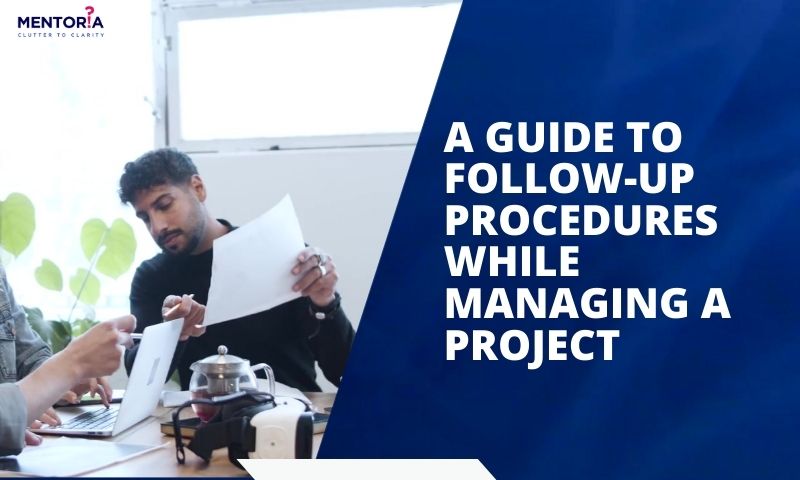A Guide To Follow-Up Procedures While Managing A Project

Whether your job title is “project manager” officially or you just oversee ad hoc projects, you probably already realise that one of the main issues with project management is that it takes more than just telling people what to do. It is simple for work to slip through the cracks if you don’t have a clear understanding of all the moving parts of your project. It is insufficient to just tell them to do this or that task; neither explanation nor preparation will suffice. Follow-up is crucial to ensuring that the work is completed correctly.
In this article, we’ll explore the importance of managing project follow-up, provide practical tips to streamline your process and also we will give some suggestions on how to follow up in a way that increases your chances of completing projects on time while decreasing your stress.
Navigating Victory: Why Follow-Up Is Your Project’s Best Ally
Effective follow-up is more than just sending out a quick email or making a few phone calls. It’s about systematically tracking progress, identifying bottlenecks, and ensuring that tasks are completed on time. By formalising your follow-up process, you’ll not only stay on top of your project but also enhance team collaboration and minimise mistakes.
One of the key reasons why a follow-up process is essential in project management is that it helps to maintain accountability. When team members know that their progress will be regularly monitored and reviewed, they are more likely to stay focused and committed to their tasks. It also provides project managers with a clear overview of the project’s status, allowing them to take proactive measures if delays or issues arise.
Moreover, a well-defined follow-up process promotes effective communication and collaboration among team members. Regular check-ins and status updates ensure that everyone is on the same page and can raise any concerns or ask for assistance when needed. This level of transparency fosters a sense of trust and encourages a collaborative working environment.
The Follow-Up Blueprint: Elements For Unparalleled Project Success
To establish an effective follow-up process for your project, there are several key elements that you should consider. These elements will help you stay organised, track progress, and address any challenges along the way.
Setting Clear Objectives And Deliverables
Before diving into the follow-up process, it’s crucial to define clear objectives and deliverables for your project. This ensures that everyone involved understands what needs to be achieved and what success looks like. Clearly stated objectives provide a sense of direction and purpose, making it easier to track progress and evaluate the project’s overall success.
When setting objectives, make sure they are specific, measurable, achievable, relevant, and time-bound (SMART). This ensures that they are realistic and can be effectively tracked during the follow-up process. Additionally, communicate these objectives to your team to align everyone’s efforts and expectations.
Establishing A Timeline And Milestones
Once you have clear objectives in place, it’s important to establish a timeline and set milestones for your project. This allows you to break down the project into smaller, manageable tasks and track progress more effectively. By having specific milestones to work towards, you can easily assess if the project is on track or if adjustments need to be made.
When creating a timeline, consider the dependencies between tasks and allocate sufficient time for each activity. This will help you identify potential bottlenecks and allocate resources accordingly. Additionally, make sure to communicate the timeline and milestones to your team, so they are aware of the project’s timeline and deadlines.
Communication And Collaboration Tools For Follow-Up
In today’s digital age, there are numerous project management tools available to facilitate effective follow-up. These tools not only help you track progress but also enhance communication and collaboration within your team. Here are some popular tools that can streamline your follow-up process:
Project Management Software: Platforms like Asana, Trello, or Jira allow you to create tasks, assign responsibilities, and track progress in real-time. These tools provide a centralised location for all project-related information and enable seamless collaboration.
Communication Tools: Tools like Slack or Microsoft Teams facilitate instant messaging and quick communication among team members. They provide a space for team discussions, updates, and problem-solving, eliminating the need for lengthy email threads.
Document Sharing And Version Control: Platforms like Google Drive or Dropbox enable easy document sharing and collaboration. This ensures that everyone has access to the latest versions of project documents and eliminates the risk of working on outdated files.
By leveraging these tools, you can streamline your follow-up process and ensure that everyone is on the same page throughout the project’s lifecycle.
Tracking And Documenting Progress
Tracking and documenting progress is at the heart of effective follow-up. It allows you to monitor the project’s status, identify any delays or issues, and take appropriate actions. Here are some strategies to help you track and document progress effectively:
Regular Status Updates: Establish a routine for team members to provide regular status updates on their tasks. This can be done through weekly progress reports or daily stand-up meetings. Encourage team members to be specific and transparent about their progress, challenges, and anticipated completion dates.
Task Management: Utilise project management tools to assign tasks, set deadlines, and track their completion. Regularly review the status of tasks to identify any overdue items. This will give you a clear picture of the project’s progress and enable you to take corrective actions if necessary.
Documentation: Maintain a centralised repository for project-related documents, including meeting minutes, project plans, and reports. This ensures that all project information is easily accessible and can be referred to during the follow-up process. Documenting decisions and actions taken also helps in evaluating the project’s success and identifying areas for improvement.
By implementing these tracking and documentation strategies, you’ll have a comprehensive view of your project’s progress and be able to make informed decisions during the follow-up process.
Addressing Challenges And Roadblocks
No project is without its challenges and roadblocks. However, with a well-defined follow-up process, you can quickly identify and address these issues to keep your project on track. Here are some common challenges and strategies to overcome them:
Scope Creep: Scope creep refers to the tendency for project requirements to expand beyond the initial scope. To address this, ensure that project objectives and deliverables are clearly defined from the beginning. Regularly review any proposed changes and assess their impact on the project timeline and resources. Communicate any approved changes to the team and adjust the follow-up process accordingly.
Resource Constraints: Limited resources can pose a challenge to project success. If you encounter resource constraints, prioritise tasks based on their impact and criticality to the project’s objectives. Consider reallocating resources or outsourcing certain activities if necessary. Maintain open communication with team members to ensure they have the support they need to overcome resource constraints.
Communication Breakdown: Effective communication is vital in project management. If you notice a communication breakdown, take proactive steps to address it. Encourage open and transparent communication among team members and provide regular updates on project progress. Consider implementing a communication escalation process to resolve conflicts or misunderstandings promptly.
By actively addressing challenges and roadblocks, you can minimise their impact on your project’s success and ensure a smoother follow-up process.
Evaluating And Adjusting The Follow-Up Process
The follow-up process should not be set in stone. It’s essential to regularly evaluate its effectiveness and make adjustments as needed. This continuous improvement approach ensures that your follow-up process remains relevant and aligned with the project’s objectives. Here are some steps to evaluate and adjust your follow-up process:
Collect Feedback: Seek feedback from your team members and stakeholders on the effectiveness of the follow-up process. Ask for suggestions on areas that could be improved or streamlined. This feedback can provide valuable insights into potential gaps in your current process.
Analyse Project Metrics: Assess project metrics such as task completion rates, adherence to timelines, and overall project success. Identify any patterns or trends that may indicate areas for improvement in the follow-up process. Analysing project metrics helps you make data-driven decisions and identify opportunities to optimise your process further.
Implement Changes: Based on the feedback and analysis implement changes to your follow-up process. Communicate these changes to your team and provide any necessary training or guidance. Monitor the impact of these changes and make further adjustments as needed.
Remember, continuous evaluation and adjustment are key to maintaining an effective follow-up process that supports your project’s success.
The Follow-Up Formula: Your Key To Project Excellence
Follow up is not just a plan; it’s a way to make sure your projects rock, By using this formula regularly, you keep things on track, face problems with confidence, and set the stage for awesome project success. It’s like having a secret weapon that turns every project into a big win now let’s discuss those formulas
Accept That Follow-Up Is Essential
Before you can implement any of the following tips, you need to analyse your mindset toward project management. If you believe that people should be able to do their jobs without any follow-up and that it’s tedious to hold someone accountable, you’ll have a hard time changing. Whether you like it or not, most people prioritise tasks where there is responsibility. Items where there is no tracking may be delayed or not done at all. Prioritising interacting with people will be simpler the sooner you embrace this reality.
Clarify Expectations
The next step to successful follow-up is to clearly describe in writing what is expected and by what date. If there are unclear expectations, it can be difficult to decide when to check in and your team members won’t know what you need to feel confident about the process. Even though you might feel your anxiety rising, you shouldn’t micromanage. Deadlines that are in between make it simpler to follow up without hesitation.
Systematise Monitoring
The less you need to think to follow up, the more likely you are to succeed. There are a variety of ways to make this easier. One is to simply have a shared spreadsheet tracking document where you record the dates of each step of the process. You can make team members responsible for completing it, and you can designate times to review it as recurring events on your calendar.
Another more sophisticated method is to use a project management system in which tasks are assigned to individuals and you can then see at a glance which ones are behind schedule and which ones are on track.
Lastly, Meetings are one way to follow up. Though it takes the longest, this approach might be the most successful one based on the risks involved in the project and the amount of feedback you believe you must provide along the way.
Increase Margin
Even with the best of systems, people sometimes miss a deadline. Instead of fighting it, embrace it and build flexibility into your deadlines. Setting deadlines in advance gives you a chance to follow up before the situation becomes serious and delays the entire project.
Talk About The Results
If team members do the job on time and well, congratulate them for it! This should never be taken for granted. However, if there are problems and a lot of stress, take a step back to evaluate the situation: If there is something you could have improved, admit it and talk to others involved. And if you’ve done your part, and the problem was really on the other end, talk about that too.
Constant monitoring is what makes projects develop in the best possible way. By investing a little time upfront, you can dramatically decrease your stress and improve your results
Decoding Best Practices For Project Mastery
To wrap up, let’s explore some best practices for project follow-up that can enhance your process and maximise project success:
Be consistent: Establish a routine for follow-up activities, such as daily check-ins or weekly progress reports. Consistency helps maintain accountability and keeps everyone informed.
Communicate expectations: Communicate expectations to team members, including deadlines, deliverables, and quality standards. This ensures everyone understands their roles and responsibilities.
Focus on collaboration: Encourage collaboration and open communication among team members. Foster a supportive environment where team members can ask for assistance, share ideas, and provide feedback.
Document decisions and actions: Maintain a record of decisions made and actions taken during the project. This helps in future reference and evaluation.
Celebrate milestones: Acknowledge and celebrate milestones achieved during the project. Recognise the efforts of your team members and boost morale.
By following these best practices, you’ll create an environment conducive to effective follow-up and project success.
Boost Your Success With Mentoria
Managing a project requires more than just initial planning and execution. A formalised follow-up process is essential to ensure that tasks are completed on time, progress is tracked, and challenges are addressed promptly. By setting clear objectives, leveraging project management tools, tracking progress, and addressing challenges, you can streamline your follow-up process and enhance project collaboration. Remember to evaluate and adjust your process regularly to keep it aligned with project objectives. With a well-defined follow-up process in place, you’ll increase the chances of project success and minimise the risk of loose ends derailing your projects.
Discover your strengths and areas for growth with Mentoria’s career guidance. Whether you’re looking to excel in your current role, explore a new one in your industry, or switch to a completely different field, our counsellors will create a personalised action plan for you. With 3 streams, 850+ courses, and 12,000+ careers, we help you find your perfect fit. Call us to speak with career mentors and kick-start your journey toward a happy and successful future.












